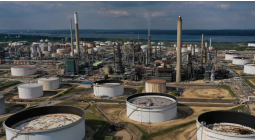‘We’re still in the 1970s with cement’: Norway plant to blaze carbon-free concrete trail

Heidelberg Materials’ cement plant with a carbon capture and storage facility in Brevik, Norway. Photograph: Ajit Niranjan/The Guardian
Shining bright among the hulking grey towers and tangled, dust-dulled pipes, at the mouth of a fjord two hours south-west of Oslo, stands a slim metal tube that may soon be hailed as a milestone in the energy transition.
The 100 metre-tall structure was erected in August with millimetre precision to trap carbon dioxide that spews out of a sprawling cement plant near the old shipping town of Brevik in Norway. Set to be finished by the end of the year, the facility will be the first of a handful around the world to capture carbon in the production of cement.
If the projects work, they could spur a wave of investments into carbon-free concrete that could prove crucial to meeting the world’s climate targets. If they flop, whether environmentally or financially, they could set back a hotly contested technology that the industry is betting on for a third of its carbon savings by 2050.
These first plants were “absolutely critical” for reducing costs and risks in the next generation, said Chris Bataille, a researcher at Columbia University and co-author of the latest Intergovernmental Panel on Climate Change (IPCC) report on solutions. “Solar and wind showed up in the 1970s, and now it’s the 2020s. We’re still in the 1970s with … cement.”
Concrete heats the planet more than flights and fast fashion, but the industry has taken few steps to clean itself up. Although manufacturers have begun to burn cleaner fuels and reuse industrial waste, they have struggled to stop emissions from key chemical processes responsible for about 60% of their carbon footprint.
In a grimy yard at the edge of the Brevik plant, surrounded by squawking seagulls and stacks of shipping containers, the project manager Anders Petersen climbed up a vast metal tank and pointed to piles of grey limestone and black coal on the ground below. The limestone releases carbon dioxide when processed in the plant’s blisteringly hot kilns, while the coal is burned for 20% of the energy it needs to hit such high temperatures.
Both materials stored carbon, said Petersen – and soon, the container beneath his feet would hold it in liquid form.
Carbon capture and storage, or CCS, is a key feature in roadmaps to a clean economy drawn up by the International Energy Agency and the IPCC. It is also expensive, energy-intensive and historically unreliable. Activists have criticised fossil fuel companies for pumping most of the carbon they have captured back into production fields to squeeze out more oil, and have dismissed investments in the technology as a greenwashing tool to excuse more drilling.
But for the cement industry, CCS is the most advanced of the solutions that engineers are racing to bring to market. Frederic Hauge, a Norwegian environmental activist and founder of Bellona, one of the few big green groups to lobby for the technology, said that public perceptions have started to change as the scale of the challenge has become clearer.
“What is the cost of not doing CCS?” he asked reporters during a press visit to Brevik. “That we will all be cooked.”
Cement producers have faced little pressure to cut their pollution but rising carbon prices and increased demand for sustainable alternatives have jolted parts of the sector into action. The emissions trading scheme in the EU will phase out free allowances for industry by 2034, and companies including Heidelberg Materials, which owns the Brevik plant, have benefited from subsidies by being first-movers. The company says it is also conscious of keeping its social “licence to operate”.
Jan Theulen, who leads Heidelberg Materials’ CCS efforts, said the company had had to develop carbon capture projects in the face of uncertainties such as the future carbon price and political willingness to support the technology. “We can’t afford to wait until all these uncertainties have become certainties.”
From the tanks overlooking the port at Brevik, Heidelberg Materials plans to ship, pipe and then pump the carbon 2.5km beneath the Norwegian seabed. The Northern Lights project, a partnership between oil companies Equinor, Shell and TotalEnergies, expects to be ready to receive its first shipment later this year as part of Norway’s “Longship” – a push to build the world’s first cross-border carbon capture and storage infrastructure. More than 80% of the project funding for the Brevik CCS project comes from the Norwegian government.
Domien Vangenechten, an analyst focusing on industrial transitions at the climate thinktank E3G, said the Brevik project was a “big deal” for the cement industry but warned against neglecting other solutions.
Emissions from cement can be reduced by substituting clinker, a polluting intermediary product that can be partly replaced by waste materials, and lowering demand for concrete – for instance, by designing more efficient buildings and cities. “To not overburden producers, consumers and taxpayers,” said Vangenechten, “we should not put all the eggs in the CCS basket.”
The first test of the technology in the construction industry is whether it can bring emissions down as much as its backers promise. The Brevik plant, which relies mostly on waste heat to power the capture process, has only enough energy to cover half of its production – for which Heidelberg Materials aims to trap 90% of the emissions. The company has launched a dozen more CCS projects in Europe and North America, a handful of which cover the full scope of production and target capture rates above 95%.
The second hurdle is the price. Heidelberg Materials has not yet set a price tag for its carbon-free cement and says it will be sold as a unique product that initially forms only a fraction of its total output. But the costly upfront investments are likely to prove dizzyingly high for a sector that is used to paying for only a small fraction of its pollution.
“Cement plus CCS will always be more expensive than just producing cement,” said Gernot Wagner, a climate economist at Columbia Business School. “The green premium in cement is real.”
For customers, the good news is that climate-friendly cement should add little to the final cost of an apartment. But while carmakers have spurred early investments in green steel by telling suppliers they are willing to pay a premium, no obvious lead market exists for clean concrete.
“There is still much less demand pull for green cement than there is for steel,” said Julia Attwood, an industrial decarbonisation analyst at the energy research firm BloombergNEF. “Customers further down the supply chain – say, the owners of large commercial buildings, or real estate developers – need to put more pressure on their suppliers to source green materials.”
In February, the new Nobel Centre in Stockholm became one of the first projects to sign up to Brevik’s carbon-captured net zero concrete. Heidelberg Materials expects other potential early buyers to include sustainable architecture firms, tech companies – flush with cash and under fire for energy-draining datacentres – and public authorities with strict green procurement rules. The road to reaching the mass market may prove rockier.
The key is now to quickly learn from early projects and bring costs down, said Wagner, “to turn low-carbon cement from a curiosity into a commodity”.




